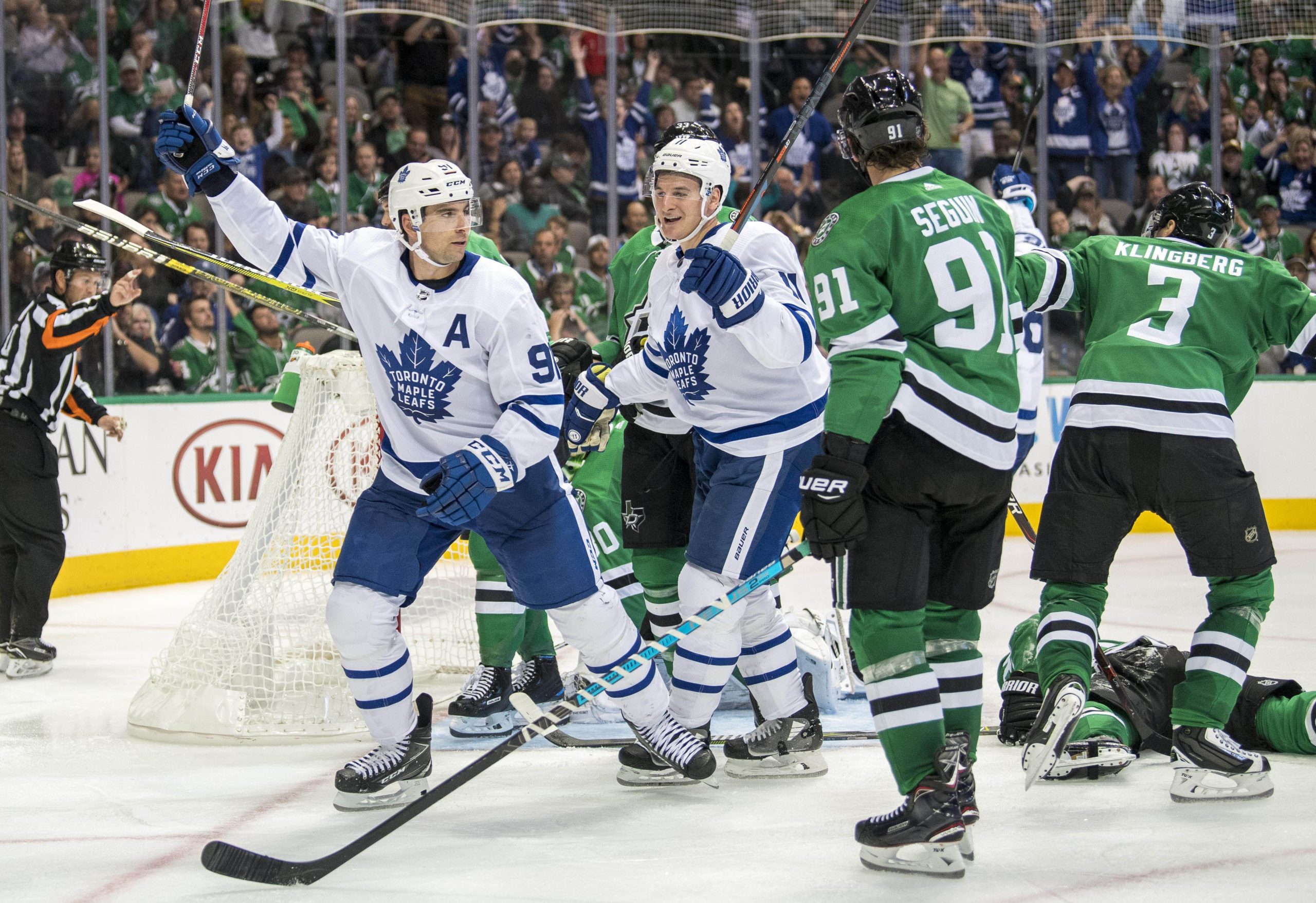We’re officially at the halfway point of the NHL season, and we also just saw some pretty unusual results at the World Junior Championship.
It’s worth pointing out, if the Leafs didn’t trade a second round pick for Brian Boyle two deadlines ago, they could have had their choice between players like Alexander Volkov, Maxime Comtois, Ian Mitchell, Josh Brook, Ukko-Pekka Luukonen, and Jack Studnicka. Keep this in mind as we head towards this year’s deadline.
Without further ado:
What Makes The Leafs Successful?
Now that the Leafs are halfway through their season, it’s time to have the “What are we?” talk. All stats are as of January 4th (via Corsica).
5v5
| Statistic | # | Rank |
|---|---|---|
| CF% | 50.93 | 11th |
| GF% | 56.76 | 3rd |
| xGF% | 51.27 | 9th |
| Sh% | 10.41 | 3rd |
| Sv% | 92.55 | 5th |
| PDO | 102.97 | 2nd |
Special Teams
| Statistic | # | Rank |
|---|---|---|
| Power Play | 23.9% | 9th |
| Penalty Kill | 79.8% | 16th |
The Leafs are slightly above average in terms of shot-attempt differential (CF%) and slightly better in terms of expected goal differential (xGF%). Despite this, they are far from an average team at five-on-five; they are third in the NHL in terms of goal differential (GF%). They have relied on both their shooting and save percentage throughout this season, and while many may believe that this is unsustainable, there are reasons to believe that the Leafs have plenty of talent in these areas.
Frederik Andersen has been one of the league’s best goalie’s over the course of his career and he’s been remarkably consistent year-to-year. John Tavares boasts a career shooting percentage of 13.2%, while Auston Matthews sits at 16.9%. Mitch Marner constantly sets up his teammates with can’t-miss chances, and there’s plenty of other good finishers in this lineup in Patrick Marleau, Nazem Kadri, Kasperi Kapanen, and Andreas Johnsson.
There’s more than one way to win a hockey game, and the Leafs don’t necessarily have to out-shoot their opponents in order to be successful. If they can just stay even on the shot clock, their scoring talent, goalie, and special teams will earn them a win the majority of the time.
The Pittsburgh Penguins won the Cup in 2016 and 2017 before the Washington Capitals won in 2018. Both teams followed the same formula as the Leafs: If they can just stay even in terms of shot attempts, they usually win the game. While the team might acquire a player or two to help them stay even on the shot clock against top teams, it’s nice to have such a clear edge.
Toronto’s statistics could continue to improve, as they’ve been without William Nylander for most of the season and Auston Matthews missed time with an injury. Marner is a magician on the power play and Nylander should help the second unit sooner rather than later, so don’t be surprised if the Leafs end up as a top-five team on the man-advantage. Running three center-right wing combinations of Tavares-Marner, Matthews-Nylander, and Kadri-Kapanen is bound to lead to success.
Sandin’s Big Showing At The World Juniors
If Rasmus Sandin shot right, his number would already be retired by the Maple Leafs organization. While Sweden’s quarterfinal loss makes it odd to call him one of the tournament’s best defensemen, he put on a show with his puck-moving ability. Leafs fans have to be thrilled with what they’ve seen from him thus far.
While I’ve already profiled Sandin in-depth here, he stands out in a major way with plays like these:
Sandin with a nice no-look back-hand pass to create an entry here pic.twitter.com/e08bIiKj8l
— Kevin Papetti (@KPapetti) January 2, 2019
Nice rush and pass from Sandin here to create a scoring chance. pic.twitter.com/R9YoMTygJ8
— Kevin Papetti (@KPapetti) January 2, 2019
This is a great pass from Rasmus Sandin. pic.twitter.com/wVPlyFVwgA
— let’s go rangres (@DraftLook) January 2, 2019
Rasmus Sandin with a good move to escape the forechecker, who goes crashing into the boards. Good breakout pass afterwards as well. pic.twitter.com/XZVU9ghYkp
— let’s go rangres (@DraftLook) January 2, 2019
Really strong play from Rasmus Sandin (TOR). Under heavy pressure near his own blueline, with little support to back him up if the puck is turned over. He’s able to break away from pressure and carries the puck in for a controlled entry. pic.twitter.com/0J3DqRLVBC
— let’s go rangres (@DraftLook) December 30, 2018
An impressive puck mover under pressure, the Leafs could certainly use help in this area –Toronto’s current roster could really use a zone exit specialist. He also keeps plays alive in the offensive zone by protecting the puck and making creative passes. Leafs fans were obsessing over Timothy Liljegren’s stretch passes at this time last year, but Sandin is the better passer of the two and is less mistake-prone under pressure.
He wins a lot of battles in the corners, but his vision is his calling card. He can escape from high-end forecheckers, thread the needle with a no-look backhand pass to find an open teammate in the middle of the ice, and rush the puck without creating turnovers.
He aggressively challenges opposing forwards and gets burned at times a result. In particular, he struggled to guard Kaapo Kakko in Sweden’s game against Finland, but he won’t be the last defender who runs into trouble with that matchup. Getting a step quicker would help him defensively, and he’s not challenging Calle Rosen as the Marlies best defender quite yet, but he’s off to a great start to his professional career.
Trevor Moore Should Be In Toronto’s Playoff Lineup
If I was in charge of Toronto’s roster, I would find a way to get Trevor Moore into the playoff lineup. He’s a tireless worker like Connor Brown, but he’s also a step quicker and he will generate more takeaways and extra offensive-zone time as a result. He could help the team’s penalty kill if he was given the opportunity and he makes the most out of his scoring chances, so I like him in the middle of the 1-3-1 powerplay.
Tyler Ennis is a fan favourite, and I’m not going to argue that he’s been bad this year, but it’s worth pointing out that he plays against easy competition and has the worst relative shot-attempt differential on the team. I like Ennis’ ability to add scoring to Toronto’s fourth line — and he can compensate for Gauthier’s lack of scoring — but Moore brings more to the table in other aspects.
It won’t happen, but a line of Moore-Lindholm-Hyman could spend entire shifts in the offensive zone. With two high-end forecheckers on the wing, they’re strong enough to protect the puck and establish the cycle in the offensive zone. Hyman will probably be used to help the Matthews-Nylander duo in this area, but I will settle for a Moore-Brown or Moore-Ennis fourth line duo. There’s no clear option to take out of Toronto’s playoff lineup, but it just feels wrong if Moore isn’t there. He’s just been so good this year.
Jeremy Bracco’s on a Roll With The Marlies
Here’s what I had to say about Bracco when I wrote about him here back on November 7th:
“Whenever Jeremy Bracco creates a high-danger scoring chance this season, no one can ever seem to capitalize. His stat line of three points in ten games is misleading as a result, and it’s only a matter of time before he starts to rack up points on the powerplay. He’s going to be a high-scoring AHL forward, and he needs to be if he ever wants to be considered for an NHL opportunity.”
A slow start to this season combined with the fact that he was a healthy scratch in the AHL playoffs made Bracco an overlooked prospect two months ago. Since then, he’s scored 29 points in 23 games and has turned himself into a point-per-game AHL scorer at the age of 21. He’s a high-end passer and power play quarterback, but I still have the same concerns that I had in November:
“Here’s the problem: He’s not excelling in terms winning battles, creating takeaways, or driving possession. He’s shifty, but he’s not particularly fast, so he’s not as strong in transition as someone like Mitch Marner or William Nylander. He doesn’t catch many opposing puck movers from behind, and he loses plenty of battles in the corners.”
Similar to Tyler Ennis, he could probably play against easier competition on Toronto’s fourth line someday while helping run the second powerplay unit. While Bracco is impressing lately, he hasn’t been better than Trevor Moore, Chris Mueller, or Sam Gagner. Much of his value comes on the power play, and it could be difficult for him to make an impact on a team that already has Mitch Marner. The Leafs could hold onto him to see if he can develop into yet another secondary scoring option, or they could look to move him as a deal sweetener at the deadline if they want to make a splash. Either way, he’s a player to keep an eye on.

































